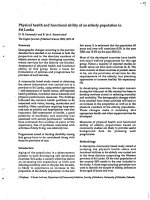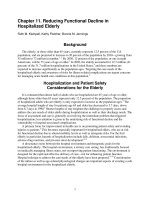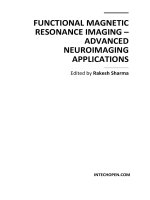Cranial nerves Functional Anatomy potx
Bạn đang xem bản rút gọn của tài liệu. Xem và tải ngay bản đầy đủ của tài liệu tại đây (1.44 MB, 163 trang )
This page intentionally left blank
Cranial nerves are involved in head and neck function, and
processes such as eating, speech and facial expression. This clinically
oriented survey of cranial nerve anatomy and function was written
for students of medicine, dentistry and speech therapy, but will also
be useful for postgraduate physicians and general practitioners, and
specialists in head and neck healthcare (surgeons, dentists, speech
therapists, etc.). After an introductory section surveying cranial
nerve organization and tricky basics such as ganglia, nuclei and brain
stem pathways, the nerves are considered in functional groups: (1)
for chewing and facial sensation; (2) for pharynx and larynx, swal-
lowing and phonation; (3) autonomic components, taste and smell;
(4) vision and eye movements; and (5) hearing and balance. In each
chapter, the main anatomical features of each nerve are followed by
clinical aspects and details of clinical testing. Simple line diagrams
accompany the text. Detailed anatomy is not given.
Stanley Monkhouse is Anatomist at the University of Nottingham
at Derby (Graduate Entry Medicine). He has been an examiner
at the Royal Colleges of Surgeons of England and Ireland; at the
Universities of Nottingham, Leeds, Newcastle-upon-Tyne, London,
Belfast, Dublin (Trinity College), National University of Ireland, King
AbdulAziz University (Jeddah, Saudi Arabia), Amman (Jordan) and
King Faisal University (Dammam, Saudi Arabia).
CRANIAL NERVES
Functional Anatomy
CRANIAL NERVES
Functional Anatomy
STANLEY MONKHOUSE
MA, MB, BChir, PhD
University of Nottingham Medical School at Derby
Sometime Professor of Anatomy at the Royal College of
Surgeons in Ireland; Lecturer in Human Morphology at the
University of Nottingham; and Clinical Assistant in Ear Nose
and Throat, Queen’s Medical Centre, Nottingham
cambridge university press
Cambridge, New York, Melbourne, Madrid, Cape Town, Singapore, São Paulo
Cambridge University Press
The Edinburgh Building, Cambridge cb2 2ru,UK
First published in print format
isbn-13 978-0-521-61537-2
isbn-13 978-0-511-13272-8
© Cambridge University Press,2006
2005
Informationonthistitle:www.cambrid
g
e.or
g
/9780521615372
This publication is in copyright. Subject to statutory exception and to the provision of
relevant collective licensing agreements, no reproduction of any part may take place
without the written permission of Cambridge University Press.
isbn-10 0-511-13272-7
isbn-10 0-521-61537-2
Cambridge University Press has no responsibility for the persistence or accuracy of urls
for external or third-party internet websites referred to in this publication, and does not
guarantee that any content on such websites is, or will remain, accurate or appropriate.
Published in the United States of America by Cambridge University Press, New York
www.cambridge.org
p
a
p
erback
eBook (NetLibrary)
eBook (NetLibrary)
p
a
p
erback
CONTENTS
List ofFigurespagevii
List of Tables ix
Acknowledgements xi
A note to the reader xiii
Part I Organization of the cranial nerves 1
1 General considerations 3
2 Cranial nerve motor fibres and nuclei 17
3 Cranial nerve motor pathways: upper and
lower motor neurons 24
4 Cranial nerve sensory fibres, brain stem sensory
nuclei and tracts 31
Parts II–V Individual cranial nerves and functional
considerations 39
5 Survey of cranial nerves and introduction to Parts II–V 41
Part II Trigeminal, facial and hypoglossal nerves 45
6 Cutaneous sensation and chewing 47
7 The trigeminal nerve (V) 50
8 The ophthalmic nerve (Va) 52
9 The maxillary nerve (Vb) 56
10 The mandibular nerve (Vc) 60
11 The facial nerve (VII) 66
12 The hypoglossal nerve (XII) 74
Part IIIGlossopharyngeal,vagus and accessory nerves77
13 Swallowing and speaking, bulbar palsy,
pseudobulbar palsy, Broca’s area 79
14 The glossopharyngeal nerve (IX) 83
15 The vagus nerve (X) 86
16 The accessory nerve (XI) 92
Part IV Autonomic components of cranial nerves,
taste and smell 95
17 Parasympathetic components and taste sensation 97
18 Smell: The olfactory nerve (I) 106
19 The sympathetic nervous system in the head 109
Part V Vision, eye movements, hearing and balance:
optic, oculomotor, trochlear, abducens and
vestibulocochlear nerves113
20 The optic nerve (II) 115
21 The oculomotor (III), trochlear (IV) and
abducens (VI) nerves121
22 Visual reflexes: the control of eye movements;
clinical testing of II, III, IV and VI 128
23 The vestibulocochlear nerve (VIII) and auditory
and vestibular pathways 133
Further reading140
Index 143
vi Contents
FIGURES
1.1 Attachments of cranial nerves, anterior view page 8
1.2 Attachments of cranial nerves, lateral view 9
1.3 Ganglia and nuclei 12
2.1 Cranial nerve motor nuclei 23
3.1 Corticonuclear pathways 26
4.1 Trigeminal sensory system 34
7.1 Trigeminal nerve 51
8.1 Ophthalmic nerve 53
9.1 Maxillary nerve 57
10.1 Mandibular nerve 61
11.1 Facial nerve (intracranial) 67
11.2 Facial nerve (extracranial) 68
12.1 Hypoglossal nerve 75
14.1 Glossopharyngeal nerve 84
15.1 Vagus nerve 87
16.1 Accessory nerve 93
17.1 Head and neck parasympathetics 100
17.2 Taste pathways 102
18.1 Olfactory pathways 107
20.1 Visual pathways 116
21.1 Oculomotor nerve 122
21.2 Trochlear nerve 123
21.3 Abducens nerve 124
22.1 Pupillary light reflex 128
23.1 Auditory pathways 134
23.2 Vestibular pathways 136
viii Figures
TABLES
1.1 Synopsis of cranial nerves page 4
1.2 Attachments and foramina of cranial nerves 7
1.3 Head and neck ganglia 14
2.1 Branchial arches, muscles and nerves 19
2.2 Cranial nerve motor nuclei 21
3.1 Voluntary (somatic and branchiomotor) motor
components of cranial nerves 28
4.1 Cranial nerve sensation, ganglia and nuclei 35
17.1 Parasympathetic components of cranial nerves 98
22.1 Pathways of light and accommodation reflexes 129
ACKNOWLEDGEMENTS
This book grew from notes first written in 1992 for medical and
surgical students at the Royal College of Surgeons in Ireland.
Comments from students over the years helped me to modify the
text, and I am therefore greatly indebted to those whom I have
taught. The notes were condensed for inclusion in my textbook
Clinical Anatomy (first published by Churchill Livingstone, 2001),
and I acknowledge with thanks the cooperation of staff at Elsevier
in allowing the use of the original notes here.
There are several people who deserve my special thanks. The first
is Eric Clarke who goaded me into action in 1992 and who has been
a constant source of encouragement and practical help. The second
is Dr Gordon Wright MA, MD, Fellow of Clare College, Cambridge,
who in 1970–1971 taught me neuroanatomy with great wit and style,
and who responded to my request for constructive criticism of an
earlier version of the text. Of course, I bear sole responsibility for
errors. I look forward to receiving constructive criticism from others.
And finally, I thank Pauline Graham and her colleagues at
Cambridge University Press.
I would like to think that this book would have met with the
approval of Maxwell Marsden Bull MA, MD, sometime Fellow and
Senior Tutor of Queens’ College, Cambridge. He had a great gift for
expository and analytical teaching, and he showed me that educare
and delectare can be synonymous.
Stanley Monkhouse
Derby 2005
A NOTE TO THE READER
For those of you who will become physicians and general practition-
ers, cranial nerves are important. Undergraduate anatomy is proba-
bly the last time you will study their anatomy, so you need to get the
hang of it first time round. This book was written with you in mind.
It assumes that you will have some understanding of the functional
anatomy of the spinal cord, spinal nerves, trunk and limbs.
If you want to jump straight to the main business of cranial
nerves, skip Part I which deals with their organization. I advise you
to try reading it sometime, though, because it covers topics that
students find troublesome but which aid understanding if properly
appreciated. If you persevere with Part I you might be rewarded
with, at the very least, a warm inward glow when the light finally
dawns on some previously murky corner.
Parts II–V deal with the functional anatomy of the nerves.
Rather than work through them from first to twelfth, the book con-
siders them according to function. You will encounter them much
as would an ingested morsel of food. This is unorthodox: it does,
though, lend spice and relevance.
There are several approaches to cranial nerves: the embryological
and evolutionary, the analytical, and that which numbs the senses
with topographical detail. Although a little of all these is desirable,
none alone is adequate. The principal emphasis of this book is on
clinically useful information, but because understanding is aided by
some analysis and embryology, the book is more than just a list of
xiv A note to the reader
points for cramming. I hope that the inclusion of some explanatory
material will stimulate you whilst not obscuring the basics. It is by
no means the last word on the subject, and I expect that research
neuroanatomists will throw up their hands in horror at some of the
generalizations it contains. It is unavoidable that some material
appears more than once, but I hope that this repetition will reinforce
rather than bore.
PART I
ORGANIZATION OF THE
CRANIAL NERVES
Chapter 1
GENERAL CONSIDERATIONS
1.1 Cranial nerves and their functions (Table 1.1)
Cranial nerves arise from the brain as twelve pairs. They
pass through or into the cranial bones (thus cranial nerves) and are
numbered I to XII roughly in order from top (rostral) to bottom
(caudal). Their functions are those of the head: some are concerned
with awareness of, and communication with, the environment; and
some are concerned with sustenance, the gut tube and movements
associated with it.
1.2 Cranial nerves and spinal nerves are differently
constituted
Cranial nerves are not equivalent to spinal nerves. All spinal
nerves have similar functions and carry similar types of nerve fibre
(motor, sensory, autonomic, etc.). This is not so for cranial nerves:
• Some cranial nerves contain only sensory fibres, some contain
only motor fibres, and some contain both.
• Some cranial nerves convey parasympathetic fibres, some convey
taste fibres, some convey both, and some neither.
Cranial nerves exhibit great variety and functional special-
ization. This is evident in Table 1.1 which summarizes their
numbers, names and main functions. Learn this table without
further ado, and make sure that you can use names and numbers
Table 1.1.
Synopsis of cranial nerves.
Name
Type Principal clinical function (other functions in parentheses)
I Olfactory Sensory Smell
II Optic
Sensory Vision
III Oculomotor Motor Movements of eyeball: most or
bital muscles. See also IV, VI
(parasympathetic: ciliary muscle, accommodation of lens, etc.; iris
muscle, pupilloconstriction)
IV Trochlear Motor Movements of eyeball: super
ior oblique muscle. See also III,VI
V Trigeminal
Va: Ophthalmic Sensory Sensation from eyeball, anterior scalp, upper fac
e
Vb: Maxillary Sensory Sensation from nasal cavity and sin
uses, palate, mid face, maxillary
teeth
Vc: Mandibular Mixed Muscles of mastication, tensor t
ympani
Sensation from chin, temple, oral cavity, tongue, temporomandibular
joint (TMJ), mandibular teeth, ear, proprioception from muscles of
mastication
VI Abducens Motor Movements of eyeball:
lateral rectus muscle. See also III, IV
VII Facial
Mixed Muscles of facial expression, stapedius (middle ear)
(parasympathetic: lacrimal, nasal, palatine, submandibular,
sublingual glands) (taste: anterior tongue)
VIII Vestibulocochlear Sensory Hearing, balance
IX Glossopharyngeal Mixed Sensation from oropharynx,
posterior tongue, carotid body and sinus
(taste: posterior tongue)
(muscle: stylopharyngeus)
(parasympathetic: parotid gland)
X Vagus
Mixed Muscles of larynx, pharynx (phonation, swallowing)
Sensation from larynx, hypopharynx, heart, lungs, abdominal v
iscera
(taste: epiglottic region, hypopharynx)
(parasympathetic: cardiac muscle; muscles and glands of foregut and
midgut: intestinal activity)
XI Accessory Motor Muscles: sternocleidomast
oid, trapezius
XII Hypoglossal Motor Tongue muscles and movements
interchangeably: in the clinical situation the nerves are often
referred to by number only.
1.3 Olfactory and optic nerves are not “proper” nerves
The first two cranial nerves, olfactory and optic, are not
really nerves at all: they are brain outgrowths, and so many general
terms are not appropriate for them. They are considered separately
in Chapters 18 and 20.
1.4 Attachments of cranial nerves (Table 1.2; Figs 1.1 and 1.2)
I and II are attached to the cerebral hemispheres, and III
to XII to the brain stem (midbrain, pons and medulla). The three
enlargements of the neural tube from which the brain develops are
as follows:
Forebrain, further subdivided into two components:
telencephalon (the cerebral hemispheres) and diencephalon
(the thalamic structures surrounding the third ventricle).
Midbrain, or mesencephalon.
Hindbrain: pons, cerebellum and medulla.
Cranial nerves arising from the forebrain: I, II
The olfactory nerve (I) is attached to the under surface of the frontal
lobe; its connections pass to the temporal lobe and elsewhere.
The optic nerve (II) is an outgrowth of the diencephalon and is
attached to structures in the wall and floor of the third ventricle.
Cranial nerves arising from the midbrain: III, IV
The oculomotor nerve (III) arises from the interpeduncular fossa
on the ventral aspect of the midbrain.
6 Organization of the cranial nerves
Table 1.2.
Attachments and foramina of cranial nerves.
Brain attachment
Nerve Foramen or canal (cranial bone in brackets)
Forebrain
Telencephalon: limbic system
I Cribriform plate (ethmoid)
Diencephalon: lateral geniculate body
II Optic canal (sphenoid)
Midbrain
Upper midbrain, ventral, interpeduncular fossa III Supe
rior orbital fissure (sphenoid)
Lower midbrain, dorsal, below inferior colliculi IV Supe
rior orbital fissure (sphenoid)
Hindbrain
Pons, lateral aspect
V Va: superior orbital fissure (sphenoid)
Vb: foramen rotundum (sphenoid)
Vc: foramen ovale (sphenoid)
Pontomedullary junction
Near midline
VI Superior orbital fissure (sphenoid)
Cerebellopontine angle
VII Internal acoustic meatus, facial canal,
stylomastoid foramen (temporal)
Cerebellopontine angle
VIII Internal acoustic meatus (temporal)
Medulla
Rootlets, lateral to inferior olive, extending IX, X, XI
Jugular foramen (between occipital and
down to cervical cord
temporal bones)
Rootlets between pyramid and olive
XII Hypoglossal canal (occipital)
The trochlear nerve (IV) is the only cranial nerve to arise from
the dorsal aspect of the brain stem; it arises just below the inferior
colliculus.
Cranial nerves arising from the hindbrain: V–XII
The trigeminal nerve (V) arises from the lateral aspect of the
mid pons.
The abducens (VI), facial (VII) and vestibulocochlear (VIII)
nerves arise from the pontomedullary junction: VI is close to the
midline, VII and VIII arise laterally in the cerebellopontine angle.
8 Organization of the cranial nerves
Optic chiasma
Pituitary stalk
Mammillary
body
Cerebral
peduncle of
midbrain
Pyramid
Olive
Medulla
Rootlets of IX
(rostral), X,
XI (caudal)
Rootlets of XII
VIII
V
VI
VII
Pons
III
IV appearing from
dorsal aspect of
midbrain
Ϫ
Fig. 1.1 Attachments of cranial nerves. Anterior view: study with
brain stem specimen.
The glossopharyngeal (IX), vagus (X) and accessory (XI) nerves
arise from the medulla by a longitudinal series of rootlets lateral to
the olive.
The hypoglossal (XII) nerve also arises from the medulla by a
longitudinal series of rootlets, but medial to the olive – between it
and the pyramid.
Medial–lateral relationships in brain stem attachments
Nerves which are attached close to the midline are exclusively motor:
III, IV, VI, XII (ignore for the moment the fact that IV emerges dor-
sally). Nerves emerging more laterally are either mixed – V, VII, IX,
General considerations 9
Optic
chiasma
III
IV
V
VI
IX
XI
X
VII,VIII
Fig. 1.2 Attachments of cranial nerves. Lateral view: study with brain
stem specimen.









